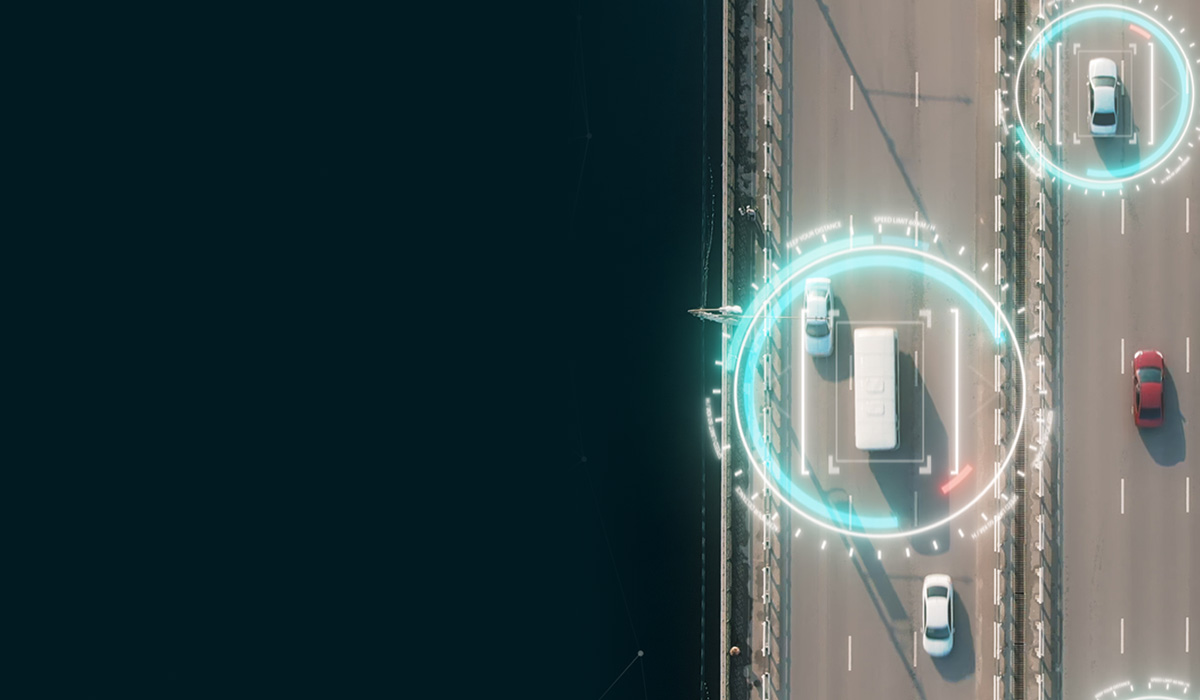
Video analytics dictates many crucial decisions nowadays, like alleviating traffic in big cities, giving access to sensitive information, and identifying people in danger. But where did it this technology start, and how far will it go?
In this article, we’ll break down everything you need to know about video analytics and how its adoption worldwide will transform our interactions with technology and our everyday surroundings forever.
Index
- What is video analytics?
- A brief history of video analytics
- How does video analytics work?
- 3 types of video analytics
- Video analytics applications
- Industries and video analytics: a promising match
- The impact of video analytics
- The future of video analytics
What is video analytics?
Video analytics or intelligent video analytics is the technology capable of generating knowledge from video transmissions, streams, or archives to detect or inform people about specific scenarios or situations.
Video analytics has always been a promising innovation aiming to unlock superhuman capacities, like detecting foes or intruders without human intervention. However, video analytics has a bit of a dark history. The first video surveillance systems were designed in Nazi Germany in 1942. It was a technology originally created to assist security tasks, especially during ballistic tests. Soon, these systems started to appear in the US and, then, all over the world.
However, this tool developed slowly, since the infrastructure and technical skills required to leverage video surveillance networks were not easy to find nor cheap. And in order for this technology to achieve similar capacities of the human eye, it had to be more and more intelligent.
Thanks to AI, this is possible today. However, we need to know the video analytics history to understand how we got here.
A brief history of video analytics
Video analytics is a technology that has slowly progressed throughout the last century and has rapidly grown in the previous two decades.
We can divide video analytics history into its three most prominent generations, from those applications that were only capable of detecting minor changes in a video stream to artificial intelligence taking video surveillance to unimaginable heights.
Here are the three generations of video analytics:
First-generation video analytics
The first generation of video analytics made the application of real-time alerts possible, striving to prevent false alarms.
However, the technology of the era was limited. It could only watch for changes in individual pixels or just a portion of them. That triggered many false alarms during heavy rains or objects waving in the wind due to storms, among other natural phenomena. The next generation of video analytics would focus on objects rather than just pixels.
This technology would allow for a better interpretation of the image, providing security professionals a greater situational understanding of the scene unfolding on camera.do so by leveraging the latest in IT-class processors that continue to evolve rapidly.
Second-generation video analytics
The second generation of video analytics focused on giving detailed forensic tools to security professionals.
Previous video analytics applications were not accurate nor fast enough to provide officers with accurate and easy to access information. The second generation of video analytics allowed officers to reconstruct what happened without having to go through hundreds of hours of video. For the first time in history, video analytics were expanding the possibilities of our relationship with technology, which would be fundamental for the next generation of video analytics.
Third-generation video analytics
The third generation of video analytics allowed a true situational awareness combined with real-time forensics.
This technology was designed to offer real-time insight leveraging all the capabilities of video surveillance networks. Through this breakthrough technology, officers were no longer limited to the machine's capacities. The system was able to spot the suspect or objective without errors. Instead of using a tool, officers were working with a true ally.
Nowadays, with the integration of video analytics and AI, the possibilities are endless. Learn more about what we are doing with this technology here.
3 GENERATIONS OF VIDEO ANALYTICS
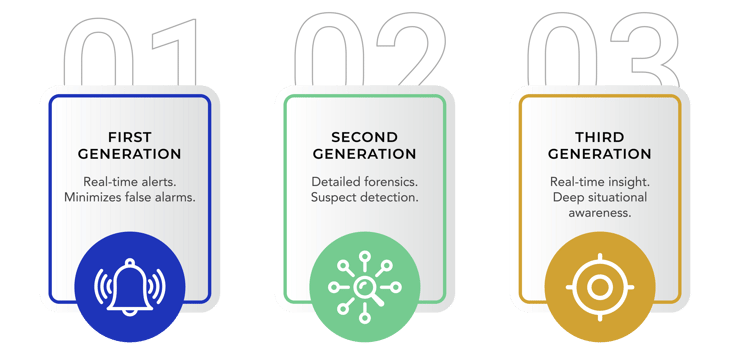
How does video analytics work?
From its inception, video analytics was designed as a solution to assist those providing security to critical infrastructures with a powerful means for identifying and detecting intruders, tracking people or objects, and producing an alarm on types of behavior.
There are numerous video analytics features that can track multiple behaviors. But the technical frameworks that make them possible are only a handful.
3 types of video analytics
Video analytics processes a digital video signal using a special algorithm to perform a security-related function. The three most common types of video analytics are fixed algorithms, AI algorithms, and facial recognition algorithms.
Here’s a quick breakdown of each of them:
Fixed algorithm analytics
Fixed algorithm analytics focuses on detecting specific behaviors, like someone entering a restricted area or someone leaving a suspicious object in a public space.
The way it works is simple: the system determines if a specific behavior is taking place in the field of view of the video surveillance network and the algorithm alerts the operators when it does. However, each algorithm only looks for a specific behavior, which can be inconvenient in quickly evolving scenarios.
The most common behaviors fixed algorithm analytics detect are:
- Crossing a line.
- Moving in the wrong direction.
- Leaving an article.
- Picking up an article.
- Loitering.
- Leaving or entering a restricted area, among others.
Artificial intelligence algorithms
Artificial intelligence algorithms learn over time when they are exposed to thousands of pieces of data to learn what is normal behavior and what is not.
The objective of this system is to learn without human intervention. This algorithm saves time to security officers and can detect behaviors that otherwise would go unnoticed by preprogrammed machines.
AI, as in other areas where it’s used, not only helps to solve problems faster and more efficiently, but also helps us to acknowledge our own blind spots in our day-to-day.
AI AND VIDEO SURVEILLANCE
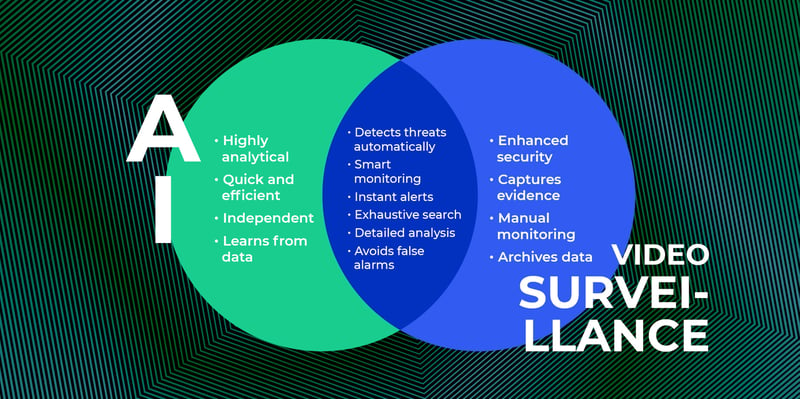
Facial recognition systems
Facial recognition systems are usually used to identify people and control access to information or specific areas, and also to help officers in open investigations.
It works by matching points on a face with a stored sample in a database. This algorithm's power relies on correctly identifying the subject among the many other faces in the database. However, this technology needs special conditions to work like good lighting or static backgrounds. But recent developments in this technology aim to fix this.
Many organizations have opposed this kind of technology due to privacy and security concerns. However, the presence and use of this video analytics algorithm has only grown over the last few years.
If you want to know more about the technology behind video analytics algorithms, read our articles on Object Recognition in Security and Vehicle Tracking.
Video analytics applications
The analytic capabilities offered today are limited only by the creativity of the user and the need presented; examples include:
Incident detection
- A system that monitors multiple areas for possible threats.
- It provides evidence to ensure the safety of all people in the area.
- It improves time response from authorities and allows for strategic planning.
Directional Motion
- A system that triggers an alarm when it detects an object moving in a specific direction.
- The users can define flexible areas of interest and various activity thresholds.
- It can be used in work and public spaces with heavy people traffic or in restricted areas.
Adaptive Motion
- Advanced motion detection that calibrates to scene conditions.
- It distinguishes targets from other movements in a scene, such as weather precipitations or other objects.
- It allows to identify people and vehicles in outdoor conditions.
Vibration Removal
- It reduces video shake in applications where cameras are subject to vibration.
- It provides a clear picture in areas where there's constant movement.
- It is used for external cameras or pole-mounted cameras.
Object Removal
- An alarm triggers when a stationary object is removed from a selected scene, such as a piece of art.
- This analytic behavior allows the user to define an object or area of interest in a scene.
- Motion is allowed in the protected zone, but if an object is removed, an alarm is triggered.
Object Counting
- A tool for heavy foot traffic flowing in and out of a specific area at a particular time.
- It detects how long a subject interacts with another.
- Useful to monitor valuable items and determine who comes in contact with them.
Camera Sabotage
- It recognizes when the video has been compromised.
- Detects when a vandal paints or covers a lens.
- An alarm is triggered if a fixed camera is moved from its original location.
Abandoned Object
- If a stationary object appears and remains in a scene, such as a suspicious package, it sets an alarm.
- It defines an object of interest and establishes a regular behavior.
- Certain movements are allowed in the protected zone, but if it detects something unusual, the alarm systems activate.
Loitering Detection
- It detects if people or vehicles remain in an established zone longer than usual.
- It notifies in real-time about suspicious behavior in key locations.
- It keeps track of suspicious people or objects.
Liquid and vessel level monitoring
- It is used as a preventive measure against floods during the monsoon season.
- The system monitors rivers to take action if necessary.
- The oil and gas sector also uses this technology for tank or vessel monitoring.
Leak Detection
- This kind of system is used for critical tasks like monitoring gas leaks.
- Infrared camera systems are used to visualize leaks.
- Thermal imaging technology allows maintenance teams to monitor gas levels, determine possible leaks, and keep assets safe from fires and explosions.
Auto Tracking
- Pan/tile/zoom capability to track vehicles or humans entering or stopping in user-defined zones.
- Once identified, the camera locks on and follows the subject’s path.
- This analytic is best for building perimeters.
Industries and video analytics: a promising match
The potential of video analytics has not gone unnoticed by crucial organizations that belong to a wide range of industries. From public security to banking, industrial operations, and retail, some of the world’s leading companies are applying the latest trends in fixed algorithm analytics, AI analytics, and facial recognition for their specific purposes as we speak.
This growing human-machine collaboration offers multiple possibilities and solutions that go from the perfecting of security operations to task optimization and, last but not least, business growth. Here are just a few examples.
4 INDUSTRIES USING VIDEO ANALYTICS
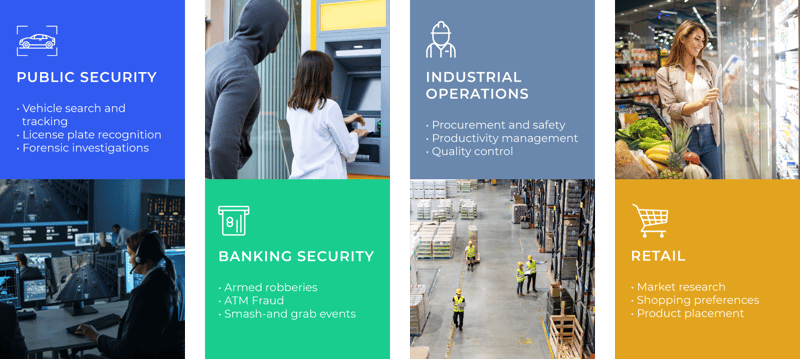
1. Public Security
It is well known that the public security industry has benefited for years from AI branches such as machine learning. However, in recent years, advances have gone beyond the imagined thanks to a subset of machine learning itself, which has even surpassed the methods of its predecessor: deep learning.
While machine learning algorithms identify images from a data set that a programmer has carefully selected and, above all, structured, deep learning imitates the tasks of the human brain. In other words, it uses algorithms that can autonomously process a large and disorganized amount of data, identifying common patterns among them and progressively grouping them. This means, then, an iterative and much more accurate identification of what is considered prohibited or unsafe.
In the context of vehicle and crowd management, the results are:
- An accurate vehicle counting and differentiation that helps detect unusual traffic behavior.
- License plate recognition of vehicles that have committed traffic infractions or were involved in an accident, thanks to an algorithm that locates license plates regardless of the positioning of a security camera.
- Identifying the excess of people in public spaces (stadiums, avenues, shopping malls) or events (concerts, games).
- Noticing movement towards prohibited or dangerous directions and thus preventing accidents.
A recent example of this is our vehicle tracking and tracing application, vehicleDRX.
Another essential ally of public security is facial recognition. Its most advanced systems analyze body language, facial expressions, and movement to detect suspicious behaviors and alert about them. They also create 3D maps of faces that are simultaneously linked to extensive databases of suspects.
Last but not least, we find different types of systems that can concentrate their detecting characteristics on a specific object and perform actions such as:
- Delimit an area or fixed object and alert at any sign of movement.
- Count people or items in a pre-established area. For example, the number of cars in a parking lot.
- Identify certain features of an object and monitor them continuously.
- Track a moving object.
In the world of vehicle security, we find autonomous AI such as Algotive's, which combines these types of object detection with video analytics algorithms, providing basic information about a car (model, last location) and even predicting its possible routes.
Learn more about video surveillance in our full article here.
2. Banking Security
Financial institutions must protect their customers and good reputation from two decisive fronts: ATM fraud and armed robberies. As in the case of public safety, banks have relied on video surveillance to meet this challenge for years. But can video analytics provide effective protection against the increasing sophistication of bank robberies?
The answer lies in combining categories such as object detection and facial recognition. In doing so, bank security systems limit the location of ATMs and identify their main components (card reader, cash dispenser, screen, etc.). At the same time, they integrate advanced AI that not only performs facial identification of suspects but learns the difference between normal activity and criminal activity, both from ATMs and people: regular cash withdrawal vs. delayed operation, customers vs. people carrying weapons or moving suspiciously. This type of fusion can identify fraud or violent use of force, monitor in real-time, and issue instant alerts, among other benefits that translate into greater customer confidence and credibility for their financial institutions.
An example of this is Algotive's DRX teller, which performs intelligent monitoring 24 hours a day, categorizes three different types of activity (non-threatening, suspicious, and criminal), and sends immediate alerts to authorities or customers.
3. Industrial Operations
Video analytics has found a promising market in the changing industrial sectors of our globalized world. The food, chemical, agricultural, livestock, and manufacturing industries, to name a few, have two common goals where cooperation between intelligent systems and collaborators is essential: ensuring safety and optimizing processes.
In terms of security, this not only encompasses the surveillance of criminal activities -also through the technologies we have already reviewed- but focuses too on protecting workers and facilities. The safety of staff in fabrics is guaranteed by deep learning algorithms that -by differentiating between dangerous and safe situations- identify early accidents or incidents and warn about them. Another major preventive advance is the implementation of facial recognition systems that detect unsafe behaviors or postures and automatically associate them with their potential accident. ISS's SecurOS™ video surveillance platform, for example, is capable of monitoring a person's skeletal structure in order to detect accepted and prohibited behaviors.
Task and logistics optimization is another goal that industries already relate to video analytics: by locating the latest generation processors and AI on their cameras and drones, they can streamline inventory management and monitor quality control. On this line, they can also choose the most convenient service for specific projects by comparing the performance and past results of different suppliers.
4. Retail
The retail sector does not concentrate technological advances such as video analytics on its staff -at least not as a priority- but zooms in on the key element of business: the customer. Deep learning algorithms, facial recognition systems, and object detection functions merge to deliver valuable information such as:
- Specific traits of customers entering a store, that is gender, age, or interest level.
- Shopping preferences and, above all, customer journeys, through an analysis of the routes they take and the time they spend checking out a product.
- days of greater customer flow.
Based on this decisive data, some of the world's leading retail companies Walmart, The Home Depot, and Costco, just to name a few- already know how to place their merchandise in strategic spots that capture client interest.
THE IMPACT OF VIDEO ANALYTICS
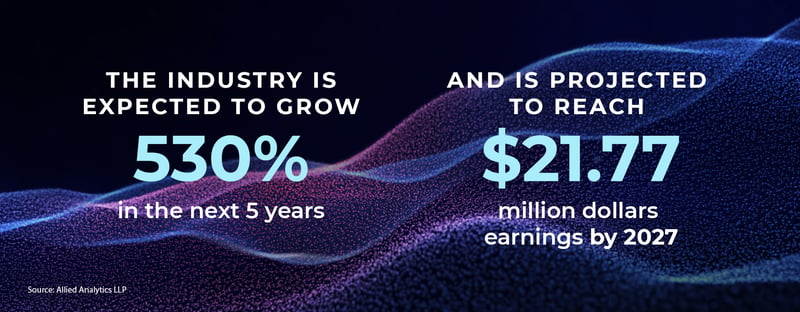
The past wrap-up makes clear that video analytics' everyday interactions allow us to open new possibilities to improve society. On the economic front, its global market was valued at $4,102.0 million in 2019 and is projected to reach $21,778.0 million by 2027 thanks to the following scenarios and trends:
- Systems with end-to-end solutions that can be integrated into various sectors (e.g. public safety and banking).
- The arrival on the market of image data sets that train new surveillance models, such as ImageNet or Microsoft Common Objects in Context (COCO).
- The adaptation of video surveillance systems to computational clouds, allowing users full control from their devices.
The future of video analytics
What's in store for video analytics in the following years? Perhaps the most certain answer is that, in the light of the many challenges our societies face, its categories will continue to be upgraded and have a greater presence in new sectors.
In addition to its innovations in the public safety, banking, operations, and retail sectors, we can expect significant applications in the healthcare arena. Given the pandemic we are overcoming, deep learning and facial recognition can reinforce health and hygiene measures against COVID-19, such as face mask detection and social distancing. They can also help identify occupancy levels in public spaces. In the domain of ethics, its video systems are expected to provide more solid solutions to cybercrime and hide sensitive information from people.
Whatever the challenges or new incursions, there is another certainty: the possibilities for reinventing video analytics promise to be as limitless as human ideas. If you want to know more about IP cameras, the most used with video analytics, read our full article here. And learn more about our video analytics suite of products, click here.
And learn everything about the core of our solutions in our Autonomous AI guide: the future of AI. Just click here!